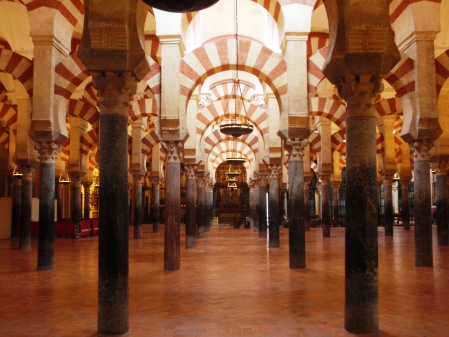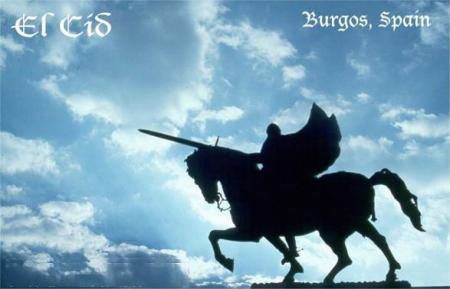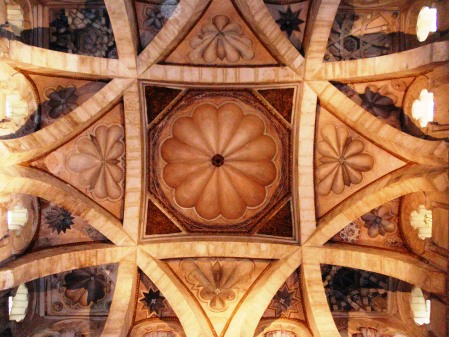“To Cordoba belong all the beauty and ornaments that delight the eye or dazzle the sight.” – Stanley Lane-Poole – The Moors in Spain
The “Twelve Treasures of the Kingdom of Spain” was a contest/poll that was conducted by the Spanish Television Company Antena 3 and the radio broadcaster Cope. The final results were announced on 31st December 2007. I thought it might be interesting to take a look at the eight out of the twelve that I have visited.
First in the competition was the great Mosque of Cordoba.
In some ways that may be seen as surprising because in the eighth century almost all of the Iberian Peninsula was conquered by hostile Muslim armies from North Africa. Only a number of areas in the mountainous north that roughly correspond to modern day Asturias, Cantabria, Navarre and northern Aragon managed to resist the initial invasion and many years before the National Hero El Cid this was to become the breeding ground of the Reconquista.
The seven hundred year period between 722 and 1492 has long been known to historians of Spain as the ‘Reconquista’ and the Spanish have organised their medieval history around the drama of this glorious event which over time has become a cherished feature of the self-image of the Spanish people.
The Great Mosque of Cordoba was, and continues to be, considered a wonder of the medieval world by both Muslims and Christians alike. Built on a Visigothic site, which was probably the site of an earlier Roman temple, the Great Mosque of Cordoba was begun between 784 and 786 during the reign of ‘Abd al-Rahman I and constructed initially from materials taken from demolished Roman structures including those as far away as Merida in Extremadura.
At the time Córdoba became the largest, richest and most sophisticated city in Western Europe. Mediterranean trade and cultural exchange flourished. Muslims imported a rich intellectual tradition from the Middle East and North Africa and Muslim and Jewish scholars played an important part in reviving and expanding classical Greek learning in Western Europe. The indigenous cultures interacted with Muslim and Jewish cultures in complex ways, thus giving the region a distinctive culture which perpetuates even today.
As well as being the second largest Mosque in the world at the time of its construction this was the grandest and most beautiful church constructed by the Moors in Spain and it is situated deep in the heart of the city amongst a lattice work of narrow streets, geranium laden balconies, secret patios and half-hidden plazas in the city’s old Jewish quarter.
I visited Cordoba on a cold day in November and was glad to get inside the complex out of the squally rain. I am certain that I wasn’t fully prepared for what I would see because here was a spectacular man made forest of rock with nearly a thousand red and cream columns of granite, jasper and marble supporting the roof and creating a dazzling visual effect.
After conquering Cordoba in 1236, Ferdinand III king of Castile consecrated the Great Mosque as the city’s Cathedral. The Christian population of Cordoba used the former mosque with relatively minor changes for the next three hundred years but in the early sixteenth century the Bishop and Canons of the cathedral proposed the construction of a new cathedral, and proposed to demolish the mosque in order to build it.
Although the city was now Christian, the overwhelming opposition of the people to the proposed destruction of the building led to the unprecedented decision, endorsed by the Holy Roman Emperor Charles V, to insert an entire Gothic chapel into the very heart of the former Great Mosque. The result of this compromise is an uneasy and controversial juxtaposition because the soaring walls of a European Gothic cathedral rise from the very centre of the comparatively low, sprawling North African prayer hall whose architectural vocabulary is rooted in the forms of classical antiquity.
When the Christian Cathedral was constructed in the sixteenth century some of the pillars were removed which I suppose might be described now as an act of abject vandalism but in actual fact, despite being a sort of cuckoo in the nest, the Baroque structure does not seem to be entirely out of place.
By the eleventh century, Muslim lands had fractured into rival kingdoms and this encouraged the northern Christian kingdoms to expand southwards with the opportunity to greatly enlarge their territories and consolidate their positions.
As early as 739 Muslim forces were driven from Asturias and a little later Frankish forces established Christian counties south of the Pyrenees and these areas were to develop into the Kingdoms of Navarre, Aragon and Catalonia. The capture of Toledo in 1085 was soon followed by the completion of the Christian reconquest of all the northern territories. El Cid’s greatest contribution to the Reconquesta came during this phase of the war and his finest victory was the capture of Valencia in 1094, which he later died defending in 1099.
After a period of Muslim resurgence in the twelfth century the great Moorish strongholds in the south fell to Christian Spain in the thirteenth, Córdoba in 1236 and Seville in 1248 leaving only Granada in the south, which since 1238 was a dependent vassal of the King of Castile.
In 1469, the crowns of the Christian kingdoms of Castile and Aragon were united by the marriage of Isabella I of Castile and Ferdinand II of Aragon. In 1478 the Moors were driven from the Canary Islands and in 1492 the Christians captured Granada, ending seven hundred and eighty-one years of Islamic rule in Iberia.
The Treaty of Granada guaranteed religious tolerance toward Muslims but the new state of Spain was beginning to flex its muscles and the year 1492 marked the arrival in the New World of Christopher Columbus and a law requiring Jews to convert to Catholicism under the Spanish Inquisition or face expulsion from Spanish territories. The Catholic Monarchy instigated a policy of unrestrained ethnic cleansing and not long after, Muslims too became subject to the same requirement.







I was there in 1990 (when I was two) and don’t know what became of my pictures so really enjoyed this! Thanks.
LikeLike
Cordoba is my favourite Spanish city (to date) and I knew most of this, Andrew, but you pull it all together so beautifully. You must have been a historian in a former life.
We were there in a chillyish May with a bit of rain about, but when the sun came out I fell in love with it.
Looking forward to the next instalment. Granada, I guess, then Sevilla of course. Toledo would be good. Madrid, naturally. Not sure after that. I’ll stick around to find out.
LikeLike
Thanks Jo – there are some surprises in this top 12!
LikeLike
Haven’t been to Cordoba but it may have to go on my list now.
LikeLike
You won’t be disappointed!
LikeLike
And me too. In two weeks I will be there and in Seville 🙂
LikeLike
Enjoy! – I know you will!
LikeLike
It was an unbearably hot August day when I visited so it was a relief to step into the cool, calm of the Mesquita. I’d been wanting to visit for ages and was not disappointed. It’s fascinating, with such varied styles of décor. Personally, I much prefer the Islamic details to the Christian so I’m really glad they didn’t tear the original building down – what a waste that would have been!
LikeLike
Amazing story and gorgeous pictures. Spain — and its north African influenced architecture — is at the top of my muse-see list. I’ll have to remember Cordoba.
LikeLike
I have not been there but after reading this, I will put it in my list of places to go when I’m in Spain again!
LikeLike
I asked you in an earlier comment what the 12 treasures were, but I did a google search and found the list. I’ve only seen one of the buildings.
The Mosque of Cordoba is magnificent – love the detail of the tiles in the photo on the bottom. I was so surprised to see a Mosque in that very Catholic country so thank you for including some of the history
LikeLike
Andrew I agree with Jo in that you must have been a historian at another time. Although the UK would not likely hire you to the tourism department Spain will want to pay you vast sums. With this post you have convinced me no trip to Spain should miss Cordoba.
LikeLike
Well, I was a historian once. I studied history at university.
LikeLike
Well that explains a great deal Andrew! 🙂 Brilliant post for sure.
LikeLike
I haven’t been to any part of Spain but it is on my list. So captivating. Sigh.
LikeLike
Put it near the top!
LikeLike
Spain is definitely next up on my list for a big trip!
LikeLike
You won’t regret it!
LikeLike
Pingback: Travels in Spain – UNESCO World Heritage Sites | Have Bag, Will Travel